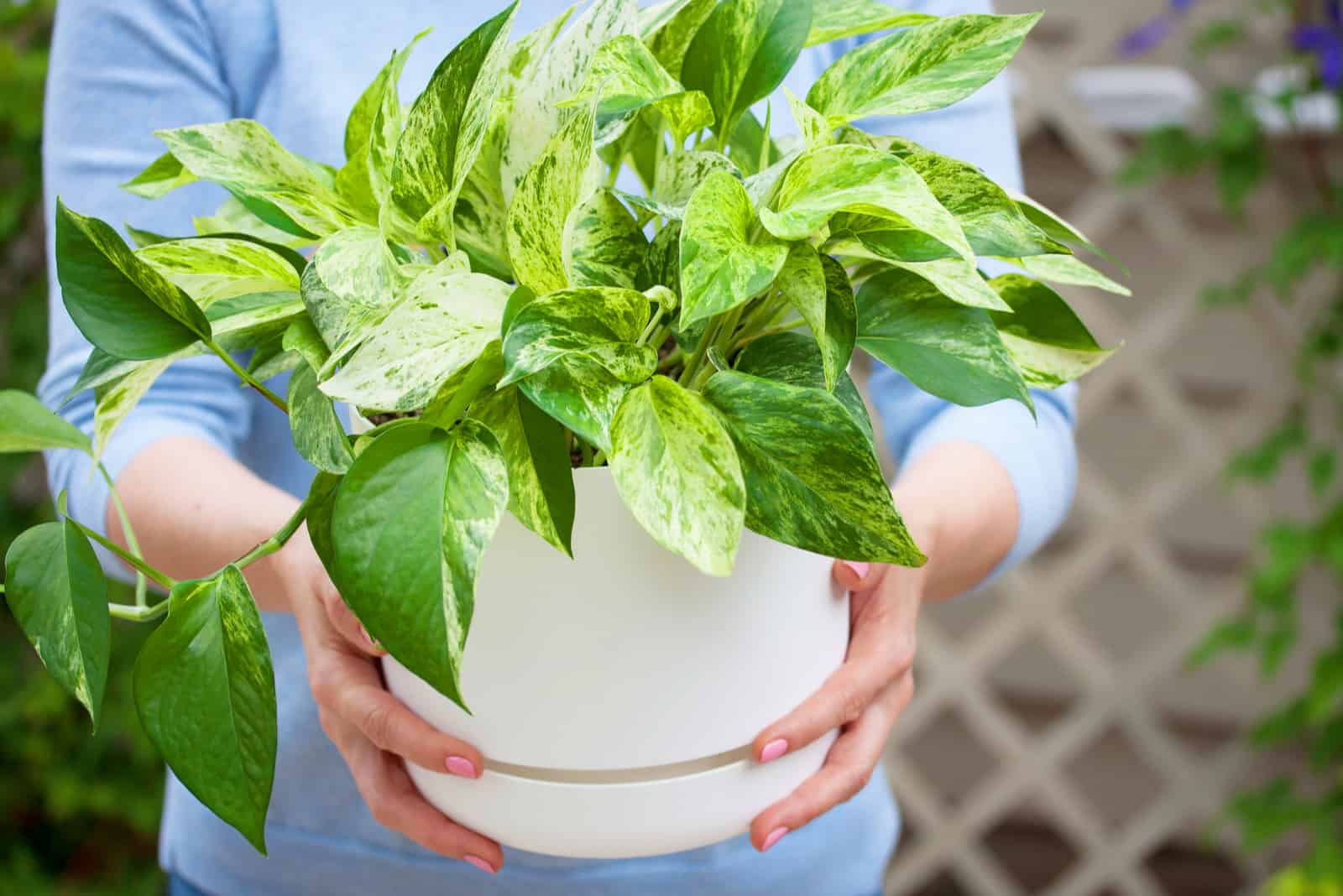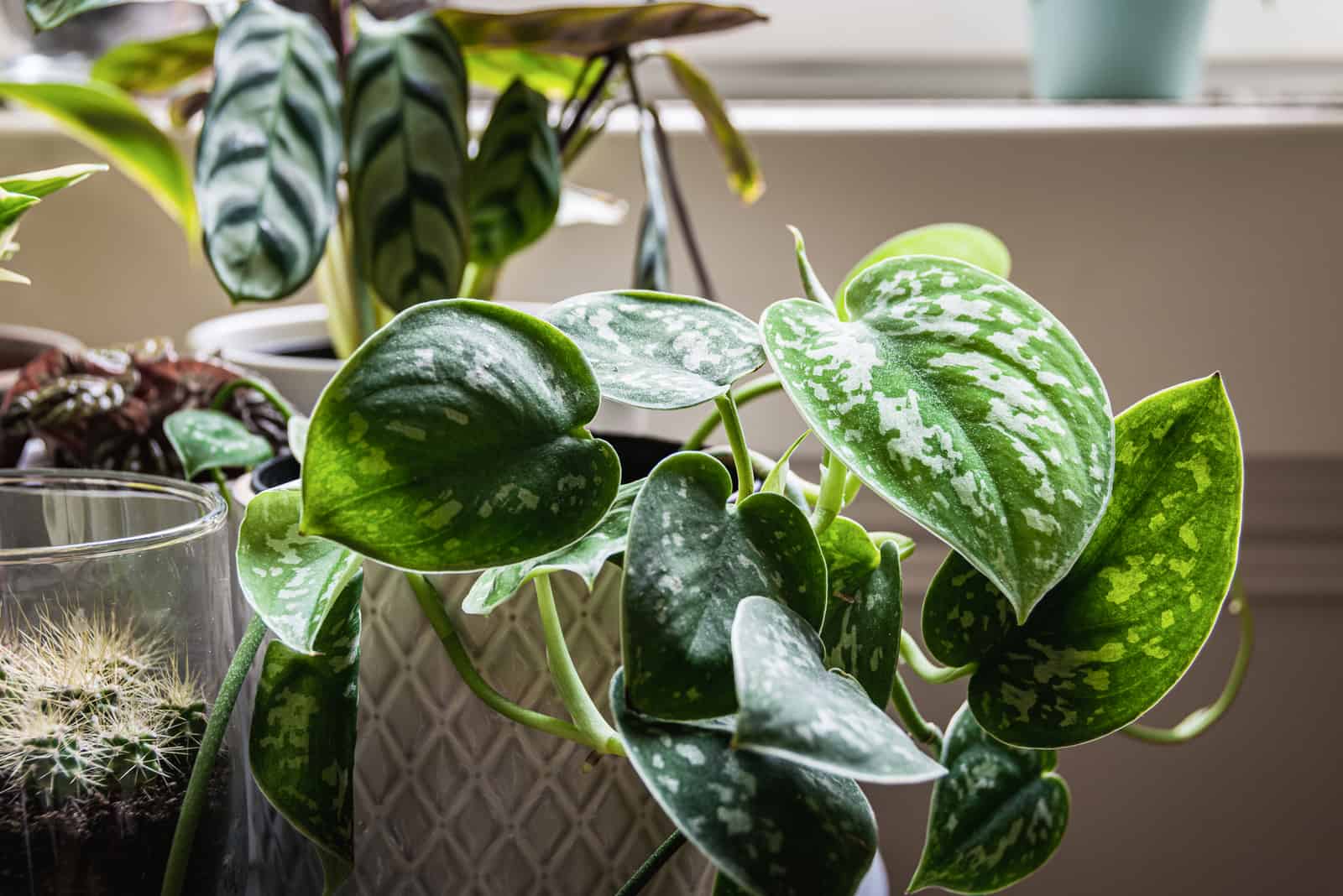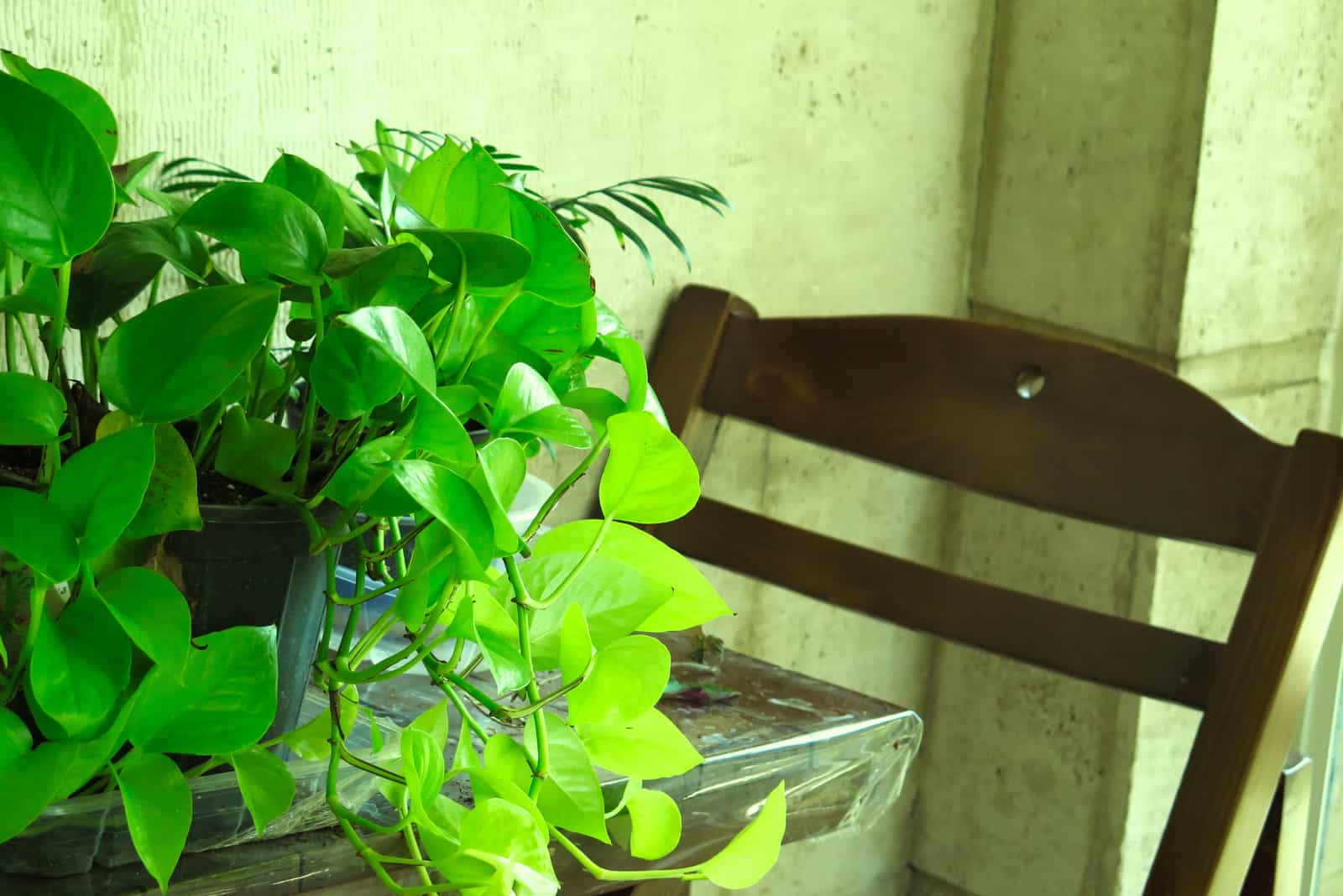Positive Bloom is an Amazon Associate and we earn from qualifying purchases through these links at no extra cost to you.
Pothos has become quite a popular houseplant amongst plant collectors, mainly because it is a low-maintenance plant that can also trail and climb, so you can decorate it in many different ways!
You have probably seen them on Pinterest home decor boards, as they are unique plants that can be grown in unusual ways, like up shelves, bed frames, walls, picture frames, and so on.
They can be used to recreate a mini indoor jungle and make your room look more lively!
However, sometimes a pothos plant just does not want to climb or trail, even though you have specifically bought it for that purpose. Don’t worry, we’ve got you!
Read on to learn tips and tricks on how to grow trailing pothos and in doing so, have the best home decor ever!
What Is Trailing Pothos?
Pothos, common name Epipremnum Aureum, is a member of the Araceae family, which has about 38 different varieties. The majority of pothos varieties have long, trailing vines and variegated heart-shaped leaves, which is why it is hard to distinguish one from another.
For instance, the Snow queen and Marble queen pothos differ mainly because of the variegations on their leaves.
The pothos is also referred to as Devil’s ivy because it is almost indestructible and will still look happy and healthy even if it has been growing in low light conditions. In nature, this plant tends to get invasive, though you won’t have to worry about this if you grow it as an indoor plant.
Not only is it used for ornamental purposes, but they are actually able to remove toxic pollutants from the air, thus purifying the air in your home and improving your health. It can also grow under fluorescent light, which is why it is perfect for offices and workspaces.
As it grows, its long vines will grow and trail on any nearby objects — I personally use them to decorate my bookshelf, though some people install an indoor trellis as an interesting decorative piece.
You can put a moss pole in a container, let the plant climb all over your walls, or grow it in hanging baskets — these baskets have hangers at the top so you can put your basket basically anywhere and the beautiful long vines and pothos leaves will topple over it.
Are All Pothos Trailing?
Whether you are growing a Satin pothos, Jade pothos, Neon pothos, or a Golden pothos, all pothos varieties have the ability to grow and trail. A Golden pothos is the best trailing plant when compared to the rest of the varieties, and you won’t have any issues with its climbing and trailing.
How To Get Pothos To Trail
You’ve just bought a brand new plant that is supposed to grow all over your walls or bookshelves. Yet, it is not growing in any direction at all.
What could be an issue in this case?
Well, there are a few things that you need to take into consideration: whether you are using the correct soil, maybe the lighting is not adequate, or the plant does not have space to grow, etc.
Now, let’s take a look so we can make sure that your pothos starts to trail.
Pick And Choose The Plant Wisely
As we have previously mentioned, all pothos are trailing to some extent — but that does not mean that every pothos will grow all over your walls!
For instance, a Marble queen pothos would rather sit on your table and act as a shrub, than grow long, trailing vines. On the contrary, a Golden pothos has no problem trailing, and will grow vigorously wherever you plant it.
So, I suggest that you buy a Golden pothos if your goal is to have a mini jungle in your room.
Get An Appropriate Container
The first thing that you have to take into consideration is ensuring proper drainage. To make sure that your plant has proper drainage, you will have to provide it with well-draining soil, but you also have to plant it in a pot that has drainage holes at the bottom.
This will help to remove excess water and keep the soil slightly moist, just like pothos prefer!
Another thing that you have to take into account is the material of your container; I personally use ceramic pots, but I think that plastic ones will do just fine.
Lastly, you can put them in hanging baskets or stationary containers.
Get Your Pothos Something To Trail On!
Your pothos will not be able to grow vigorously if it does not have anything to grab on to. Therefore, you should provide it with some kind of support and then assess its trailing habit.
You can install a moss pole — this will help your greenery to climb around the pole, and a pothos absolutely loves moss, which makes its whole trailing job a lot easier.
Another thing that you can also use are metal poles (but not the kind that probably popped into your head). These poles are much more practical and strong, thus they will be able to support a matured trailing pothos.
To spice up your home decor you can also use bamboo canes as a support for your pothos. Quite easy to install, bamboo canes are sturdy enough to support a trailing pothos to grow up and to look as beautiful as ever!
Another, yet not as common, type of support for indoor gardens is a trellis. Nonetheless, it is a beautiful decorative piece and enables the pothos to spread its vines all over it! Bear in mind that your trailing pothos will grow according to the size of the trellis, it won’t be able to outgrow it.
If your goal is to grow it on shelves or frames, I recommend that you use hooks. Even though I’ve seen that many growers use tapes or staples, these can suffocate the vines or puncture them, making them more susceptible to pests and diseases.
You will just end up with a browning vine that you will most likely have to cut off.
The best way to avoid this is to use hooks that enable your plant to grab on: they are cheap and can be found almost anywhere!
You don’t have to worry about them ruining your aesthetically pleasing trailing pothos, these hooks are barely visible and you can also use decorative kinds.
Provide Soil That Is Rich In Nutrients
Your pothos will thrive in soil that is rich in nutrients, therefore, you should provide it with an appropriate potting mix that contains all of the necessary nutrients.
You can also make one yourself, but more about that in the section where we talk about pothos plant care.
Bear in mind that the pH of the soil should be from 6.1 to 6.6; and also that the soil should be porous and light, especially in hanging plants.
Adjust The Lighting
Not only will poor lighting conditions make your plant lose its variegations, but it will also prevent it from trailing.
If you leave your trailing pothos in low light conditions, the beautiful patches on its leaves will disappear and the plant won’t be able to get energy from the light and grow. On the other hand, exposure to direct sunlight might lead to the burning of its leaves and discoloration.
Pothos grow best in bright, indirect light. Therefore, you should put it near a window that gets enough indirect sunlight throughout the day.
If you don’t have that kind of window, you can always use artificial growing lights — trust me, pothos vines won’t be able to tell the difference and they will grow and develop in the same way they would under indirect sunlight!
Don’t Skip Pruning
Pruning helps to maintain the plant’s shape, but also promotes new growth!
As they are relatively fast growers, you should prune them every other month, or even earlier if you see browning stems and leaves. Pruning will give your plant that special glow, and it will look so happy and healthy!
It is also important to remove any dead leaves from the plant pot, as they are filled with bacteria and microbes that might attack the roots in the soil as they decay.
Another great thing is that you can use these stem cuttings for propagation as well! More on that later, now we are going to focus on how to prune a trailing pothos:
• You should always use sterile pruning shears or scissors.
• Cut slightly above the leaf node. You should cut the browning pothos vines first, as they won’t grow anymore and the nutrients won’t get stuck on these dead areas anymore.
• It would be best to cut the stem diagonally to encourage proper growth.
• Remove any yellowing leaves to promote nutrient flow and prevent pest infestation.
• Continue with adequate plant care, primarily regarding watering and light conditions.
Stick To Adequate Plant Care
Just as your body grows and develops when you start exercising and eating good food, the same can be applied to your trailing pothos.
I am not talking about your plant hitting the gym, but rather giving it water and proper plant food to grow and develop.
Inadequate watering is a common issue in pothos care guides, as it can easily lead to overwatering and stunted growth.
They prefer having moist soil that is not too wet or too dry, so you should always check the soil before watering. Read more about watering requirements in the plant care guide.
How To Take Care Of A Trailing Pothos
Pothos are great plants for beginner gardeners who want to start their own plant collection or attract a bit of good fortune and positive energy, as pothos is one of the most famous money plants!
That’s right, it is believed that a pothos is able to attract good energy and prosperity into your home, which is yet another reason to get yourself a pothos plant.
Now, let’s take a look into this money maker’s plant care!
Soil Requirements
Pothos plants require well-draining soil to minimize high moisture retention. Root rot is caused by too much water in the soil, therefore choosing the right soil is crucial.
The ideal soil mix and drainage holes on the pot’s bottom will aid in the removal of excess water. You can either buy or prepare your own aroid potting soil.
You should combine perlite, universal soil mix, and peat moss to make the best potting mix. This mixture can also be used to grow philodendrons.
Watering Requirements
During their growing season, which is in the summer, pothos plants need to be watered more frequently (once a week).
During the winter months, however, they need only be watered every two weeks.
A pothos does not like wet soil, since it might cause root rot. Overwatering must be avoided at all costs!
When it comes to watering, the best strategy is to wait until the soil is fully dry before watering again. This can be done with either your thumb or wooden chopsticks.
Light Requirements
As we have previously mentioned, a pothos prefers indirect sunlight.
You can put your new houseplant in a hanging basket near the windows or on a window that doesn’t get direct sunlight.
Because the variegations on the leaves can fade completely in direct sunlight, which would be unfortunate because the leaves are the most significant element of this gorgeous houseplant, it’s crucial to keep it out of direct sunlight.
Temperature Requirements
Pothos are tropical plants, thus, they thrive in warm temperatures.
If you have a pothos plant, you should be aware that it can tolerate temperatures ranging from 55 to 85 degrees Fahrenheit, though it prefers temperatures between 70 and 90 degrees Fahrenheit.
Any lower temperature would be harmful to your pothos, and any higher would be too hot to handle.
Humidity Requirements
Being tropical plants, they prefer growing in a humid environment. Your pothos plant can tolerate some dry air, though the humidity levels should not drop below 50%.
The most optimal humidity levels are around 70%. So, if you are having issues with the humidity conditions, here are some ways to boost up the humidity:
• You could invest in a humidifier, which is an expensive choice. However, you can always find a less expensive humidifier and save some money!
• To keep your plant moist, be creative and make a DIY pebble tray: simply arrange pebbles in a tray, fill the tray with water, and place your plant on top. The moisture that your plant requires will be provided when the water evaporates.
• The most practical option is to keep it in a humid environment, such as the bathroom; just make sure your Pothos plant gets enough indirect light.
Fertilizer Requirements
Some folks think that a pothos does not require any fertilizer.
A little plant food won’t harm your plant though!!
During the growing season, a pothos should be fertilized frequently. Then, you can take a rest during the colder months.
Slow-release or liquid fertilizers can be used, depending on the pothos variety in question.
Definitely choose a nitrogen-containing type of fertilizer because they encourage lush foliage growth, so your pothos plant will produce many more leaves during its growing season.
Repotting
The best time for repotting is at the beginning of the growing season, during spring or early summer. It is not recommended to repot it during winter, as the plant is much more sensitive and its roots can be easily damaged.
Pothos should be repotted every 2-3 years (their growth rate also depends on the conditions provided), and you should always use a bit of a larger pot than your previous one.
Make sure to water your plant the day before repotting as it will help to loosen up the soil and make the job a lot easier.
Prepare an adequate potting mix and fill half of the new pot. Place the plant in the middle, then fill out the rest of the pot with the same potting mix. You can add compost if you want, to help the plant settle in.
Propagation
Propagating pothos is the best way for beginner gardeners to learn how to propagate a houseplant because it is so easy and won’t take too much time and energy.
There are two methods that you can use: root propagation and water propagation. Both methods are effective, though I somewhat always prefer root propagation.
Root Propagation
Root propagation can be conducted when you are repotting or pruning your plant. It requires stem cuttings and planting it into a new pot.
1. Find a healthy stem that has at least four leaves on it, and cut about 5 inches in length.
2. You can dip the cutting into a rooting hormone, though this step is optional.
3. Make sure that you have already prepared potting soil. Follow the steps from the plant care guide.
4. Make sure that you don’t expose the cutting to any direct sunlight and keep it at its preferred temperatures.
Water Propagation
This method has become more practiced than root propagation because you are able to see the root development in the water.
1. Same as before, find a healthy stem with leaves and cut it to about 5 inches.
2. Put the stem cutting in the water. You can either use a glass, jar, or vase.
3. Keep it in indirect sunlight.
4. It will take about a month for roots to establish. Once you notice this, plant the cutting in the soil.
Check out this video for more information about pothos propagation:
Pests And Diseases
Another feature that makes these plants perfect for beginners is that they are not prone to various pests and diseases!
Sure, they can get pest infestations but they are easily fixed.
The common pests that tend to invade a pothos are mealybugs and scales. These pests love to settle in and make a home out of your plant and steal its nutrients at the same time.
They can be easily removed by using rubbing alcohol or neem oil at the site of the infestations.
The disease that is the most common in pothos is root rot. Root rot is a serious fungal infection that is caused by overwatering. If not treated immediately, it can lead to your plant’s death.
To get rid of root rot, you will have to take the plant out of the soil and cut off all those mushy and decaying roots, then put the plant in new soil because the previous one will be infected. I also suggest that you use a new pot because there can still be fungus in the previous one.
The Best Trailing Pothos Varieties
When you go into a plant shop or look for trailing pothos online, you will be bombarded with numerous plants that are somewhat similar to one another, yet they have different trailing habits.
Here, we are going to cover the best trailing pothos so you can get creative with the trailing vines as soon as possible!
1. Jessenia Pothos
Jessenia pothos have variegations similar to Marble queen pothos, though they have a far glossier texture.
These heart-shaped leaves and long vines tend to spread at a fast pace, and I doubt that you would run into any issues with these trailing pothos.
Bear in mind that all pothos will grow all over a trellis, and you might have to prune it to maintain the shape.
2. Golden Pothos
As we have previously mentioned, a Golden pothos has the ability to trail quickly and easily, and does not require any special plant care, thus, it is perfect for gardener newbies!
It has round leaves with yellow patches, making it more distinguishable than the rest of the pothos varieties.
It is also one of the 10 types of money plants, so you can look at this plant as an investment that will attract your money back!
This pothos can grow up a moss pole, or up a trellis.
3. Njoy Pothos
This type of pothos has much whiter variegations when compared to the rest of the plants in this genus.
It has remarkable trailing abilities and is usually grown for minimalistic home decor. It can be used as a frame, though it also looks perfect on shelves, or in a hanging basket with its vines falling and swaying in the breeze.
4. Neon Pothos
I know that neon and LED lights have become popular in the past few years, but wouldn’t it be better to have an actual neon plant growing in your room?
Neon pothos produce bright green leaves that look like a neon color, hence the name of this variety.
It has a tendency to trail, yet not as much as the previously mentioned pothos.
5. Manjula Pothos
Similar to the Marble queen pothos, the Manjula pothos have white and creamy variegation on both sides of their leaves. It is a patented Pothos variety, originating from India.
This is one of the most expensive pothos, though it is worth it because of its mesmerizing leaves and trailing vines that make a great addition to a home and make it look more lively!
6. Cebu Blue Pothos
Cebu Blue pothos are plants that have been on my wish list forever! They are extremely rare, and I swear I have been trying to buy one for months, and still, nothing.
This pothos variety is not actually an Epipremnum aureum, but it is called Epipremnum pinnatum.
It has plain green leaves with almost no variegations, though you are sometimes able to see the silver sparkly patches when it has been grown under proper conditions.
The shape of the leaves also differs from a E. aureum; Cebu blue pothos have arrow-shaped leaves, while the pothos that we have mentioned previously, all have either round or heart-shaped leaves.
7. Marble Queen Pothos
Though it is a slow grower, and is often grown as a little shrub, Marble queen pothos also have the ability to trail. They can take a couple of years too and many folks don’t have time to wait for theese pothos to trail, thus, they grow them as a small plant in the pot.
Whatever way you choose to grow one, you will get an amazing plant that has simply mesmerizing marbly leaves!
Bear in mind that this variety is sensitive to light, and low light conditions will cause the fading of its variegations. In this case, just provide your plant with more bright and indirect light.
Final Thoughts
What to say other than that the trailing pothos are great houseplants for many reasons: it is not hard to take care of one, they can grow beautiful trailing vines all over your shelves or walls, and they can purify the air in your room at the same time.
This plant is primarily used for ornamental purposes, as it produces heart-shaped leaves with different variegations on them, which makes this plant truly unique.
It can be easily propagated and repotted, making it a great practice plant for beginner gardeners.
You can also get creative and use these long pothos vines to decorate your closet, pictures, bed frames, and such. Many great ideas can be found on Pinterest too, but most importantly have fun with it and use your imagination!
Until next time!
Like this post? Share or pin it for later!





